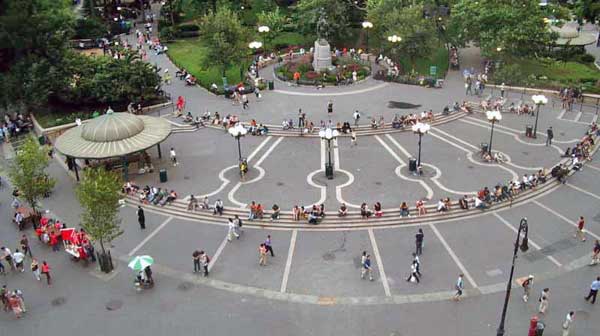
Union and Confederate troops never fought here, but the city became a battleground just the same, hosting political brawls, patriotic rallies, parades, riots and a terrorist attack. Long after Democrats proposed seceding, to maintain trade with the South, the city remained a hotbed of anti-war, anti-emancipation sentiment. In 1863 the first military draft ignited a three-day riot, finally quelled when Abraham Lincoln sent troops. In November 1864, pro-Rebel “terrorists” plotted to destroy hotels and theaters with incendiary devices. Fortunately, the attackers hid their smoldering carpetbags and fled.
New York’s war ended—as it began—with a parade, when Lincoln returned as a martyr; for the largest funeral the city had ever seen. Twenty years later the city mourned the war’s other great Union hers, Ulysses S. Grant. Though few landmarks have survived years of sprawl and dizzying vertical growth, today’s visitors can still find evidence of the war.
City Hall
Broadway and Chamber Street, Google Map
Lincoln visited here en routed to his inauguration. Four years later, thousands viewed the president’s remains as he lay in state atop the staircase under the Rotunda. The Governor’s Reception Room are open to the public by appointment.
City Hall Park
This tiny jewel once housed Barnum’s Museum of Curiosities. In 1865 “Jefferson David” was hanged in effigy here. Farther south stood Newspaper Row (a statue of Horace Greeley graces the eastern front of City Hall) Father downtown, picture publishers, including Currier & Ives, cranked out patriotic images. On Nassau and Spruce Streets, old buildings still evoke 19th-century ambience.
Union Square
14th Street, Google Map
A onetime pauper’s graveyard, this park was named not for the nation but for the convergence of the Bowery and Broadway. Henry Kirke Browne’s statue of George Washington was draped with Fort Sumter’s tattered flag at an 1861 rally where 100,000 New Yorkers pledged to “rally to the star spangled banner.” Henry Kirke Browne added the bronze of Lincoln at the park’s north end in 1870.
Cooper Union
Astor Place, Google Map
Lincoln delivered his “right makes might” speech in the Great Hall, which looks much as it did when Lincoln spoke on February 27, 1860—complete with the cast-iron rostrum he used.
Draft Riot Sites
Since the July 1863 riots raged in so many different areas from July 13-16, 1863—or because the city preferred to forget its horrors—no historical markers identify precise locales. Rioting first broke out at the draft office on the east side of Third Avenue between 46th and 47th Streets, reemerging along what is today Central Park South (59th Street), where today Augustus Saint-Gaudens’ deteriorating but extraordinary gilded statue of William T. Sherman reigns on Fifth Avenue. The most horrifying inciendent occurred on the west side of Fifth Avenue between 43rd and 44th Streets, where marauders attacked a “Colored Orphans’ Asylum”.
The New-York Historical Society
Central Park West at 77th Street, Google Map
The most comprehensive Civil War collection in the city includes Louis Lang’s Returns of the Irish Brigade after Bull Run and Francis Carpenter’s chiaroscuro of the Lincoln Family in 1861, for example. The N-YHS plans to install one war-era treasure a month during the sesquicentennial.
Grant’s Tomb
Riverside Drive at 122nd Street, Google Map
The exterior, by John Hemenway Duncan, owes a debt to the Mausoleum of Halicarnassus in Turkey, while its interior resembles Les Invalides. The eagles on the front steps come from the old New York Post Office.
Seventh Regiment Armory
Park Avenue at 67th Street, Google Map
See Thomas Nast’s magnificent Departure of the Seventh Regiment, depicting recruits marching down Broadway in April 1861.
The Metropolitan Museum of Art
Fifth Avenue at 82nd Street, Google Map
The American Wing boasts Thomas Hovenden’s Last Moment of John Brown, classics by Winslow Homer and bronzes of Admiral Farragut, The Freedman, and Lincoln (a newly acquired Saint-Gaudens).
The Union League
Park Avenue at 37th Street, Google Map
If you know a member, beg for a glimpse at the fabled collection here, including Eastman Johnson’s iconic The Wounded Drummer Boy and Thomas Nast’s sketch of Lincoln entering Richmond. Tucked into upstairs meeting rooms are the original oil models for Carpenter’s masterpiece, The First Reading of the Emancipation Proclamation.
A View From the Bridge
Just across the East River are the wartime sites of Green-Point Works (where USS Monitor was fast tracked) and the Brooklyn Navy Yard, a center of naval repairs and training. Brooklyn itself, rich in wartime history, is another story.




